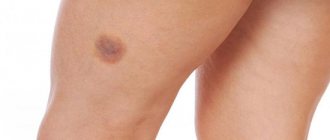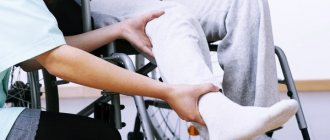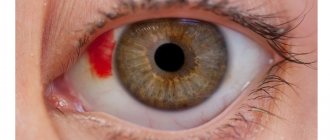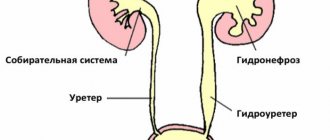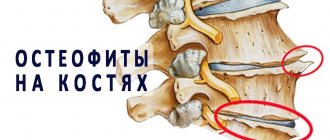A pinched nerve in the back is accompanied by a sharp pain syndrome, which can be shooting, burning or stabbing in nature. People with this symptom often complain of unbearable pain that does not go away even during sleep.
Pain can be localized in the neck, thoracic or lumbar region. Often the pain spreads to the arms, legs, groin and buttock area. Damage to the cervical spine is accompanied by headaches, dizziness, changes in blood pressure and deterioration of the psycho-emotional state.
Causes
In most cases, the painful attack occurs unexpectedly and is often caused by excessive exercise and heavy lifting. The most common cause of a pinched nerve in the back is degenerative changes in the spine and exacerbation of osteochondrosis.
With age or under the influence of unfavorable factors, the intervertebral discs become thinner and the distance between the vertebrae decreases. In addition, the vertebrae begin to put more pressure on each other, which contributes to the formation of protrusions and hernias.
With spondylosis and advanced forms of osteochondrosis, bone growths appear on the vertebrae - osteophytes, under which nerve roots often fall. As a result, the spinal nerves may become pinched by the vertebral bones, the displaced outer ring of the disc, or osteophytes.
Pinched spinal nerves can be caused by muscle spasms, hypothermia, or injury. Muscle spasm, in turn, is a consequence of intense sports training, prolonged stay in an uncomfortable position and low physical activity.
In the thoracic region, dystrophic changes develop extremely rarely, since this segment is almost motionless due to its tight connection with the ribs. However, curvature of the spine (scoliosis, kyphosis) is often observed here, which can also be the cause of pinching of the spinal or intercostal nerve.
The main cause of a pinched nerve in the lower back is fatigue and muscle tension due to sudden movement and excessive physical activity. An increased risk factor is congenital anomalies of the lumbar vertebrae:
- lumbarization (6 vertebrae instead of 5);
- sacralization (4 vertebrae instead of 5);
- irregular shape of intervertebral (facet) joints - butterfly and wedge-shaped;
- Non-fusion of the vertebral arches (spondylolysis);
- motionlessly connected lumbar vertebrae 1–3;
- distorted shape and deviations in the size of the vertebral processes;
- spondylolisthesis (displacement of the vertebrae) - can be either congenital or acquired.
Reference: congenital defects of the lumbar vertebrae occur in almost 30% of the world's inhabitants, so about a third of the population is at risk of experiencing symptoms of a pinched nerve.
In rare cases, nerve root compression is caused by a benign, malignant, or vascular tumor that destroys the vertebra; metastases from other organs; inflammatory process in the spine against the background of infectious pathologies, as well as rheumatic diseases.
It should be noted that people engaged in heavy physical labor, athletes and pregnant women are more susceptible to various damage to the spinal nerves.
Symptoms of a pinched nerve in the spine
The clinical picture of the pathology depends on the location where the pinching occurred, therefore there are several types of pain syndrome:
- cervicalgia - pain and tension in the neck muscles, often accompanied by headache, dizziness, limited mobility and decreased visual acuity;
- cervicobrachialgia – neck pain radiating to the arm;
- sciatica – lower back pain that spreads along the back of the leg and can reach the foot;
- lumboischialgia - pain in the lumbar region, spreading to the thigh, one or both lower limbs;
- lumbodynia – pain in the lumbar region.
A disc herniation can occur in any part, but most often it forms in the lumbosacral region.
If the nerve is pinched in the cervical region, pain can be felt not only in the neck, but also in the occipital, cervical-collar area and arm on the affected side. If the nerve is damaged at the level of the 3rd vertebra, there may be numbness in the sublingual area, changes in taste and difficulty speaking.
Damage to the nerve near the 4th vertebra is accompanied by discomfort and pain in the area of the collarbone and forearm, decreased muscle tone, and dysfunction of the respiratory system. Sometimes the pain radiates (gives) to the chest and right hypochondrium.
A characteristic sign of a pinched nerve at the level of the last vertebrae C 6 - C 7 is weakness and numbness of the upper limb from the shoulder to the hand.
A sharp and piercing pain between the shoulder blades accompanies intercostal neuralgia, in which the intercostal nerves extending from the spinal roots are compressed. In this case, the back also hurts in the area of the ribs, often the pain syndrome is of a girdling nature.
Inflammation of the lumbar nerve is manifested by intense shooting and throbbing pain. It is most pronounced in the first half hour after the onset of the attack and can last up to several hours, then gradually passes.
If the sciatic nerve is damaged (lumbosacral radiculitis), the pain occurs mainly in the gluteal region and the back of the leg. Moreover, the pain can affect both the entire limb and its individual parts - for example, it can be felt only in the popliteal fossa, thigh or lower leg. In most cases, the lesion is unilateral.
The mechanism of pain development is almost always the same and does not depend on the cause. As a result of shift or deformation of the vertebral structures, excitation of many nerve endings occurs, which are supplied to the outer ring of the disc and the ligamentous apparatus. The result is severe pain and spasticity in the muscles surrounding the spine.
Nonsteroidal anti-inflammatory drugs
NSAID ointments are loved and appreciated by doctors for their high effectiveness in treating pinched and inflamed sciatic nerves. After their use, pain and inflammatory symptoms go away almost immediately. They are often prescribed in situations where sciatica is caused by cold or injury.
They are the number one remedy, as they quickly eliminate painful symptoms. But the duration of treatment with NSAID medications should not exceed more than 5 days. Restrictions on use include childhood, gestation and lactation. These include:
- "Piroxicam". Has analgesic, anti-inflammatory and anti-edema effects. A common ointment for inflammation of the sciatic nerve;
- "Nise." Widely used for external use for pain syndromes, quickly treats the symptoms of sciatica. The frequency of lubrication varies from 3 to 5 times a day;
- "Ibuprofen." Quickly helps to cope with pain when pinched, eliminates swelling and inflammatory manifestations;
- "Ketoprofen". An effective ointment for the sciatic nerve with severe pain with pronounced signs of local inflammation.
Can your back hurt from nerves?
Frequent nervous stress and emotional overload are quite capable of leading to decreased immunity and exacerbation of chronic diseases. And first of all, it is the back that suffers, especially the spine. Negative emotions affect muscles, causing them to contract and tense. The process immediately involves the ligamentous-tendon apparatus, joints and intervertebral discs.
As a result, blood circulation is disrupted, muscle tension occurs, and the back begins to hurt. Muscles are the main target of chronic stress: if they normally contract only during physical effort, negative emotions make them stiff and stiff until the person calms down.
The connection between peace of mind and physical well-being has been known to humanity since ancient times. It is no coincidence that doctors 100 years ago diagnosed “irritable spine” when the patient complained of pain in the neck, under the shoulder blade or in the lower back.
In the absence of organic problems, “stress pain” is treated comprehensively, using pharmacological and psychotherapeutic methods.
People who experience prolonged stress often lose control of tense muscles, and along with it, the ability to relax. This can often be seen in appearance: a person pulls his neck into his shoulders, stoops and seems to have difficulty moving his legs.
Thus, an incorrect motor stereotype is formed, and from constantly being in non-physiological positions, the muscles are loaded even more, and the pain increases. And the more noticeable the pain, the more tense the muscles. The circle closes...
How to recognize that the cause of pain is in the nerves? Neurologists and psychologists are confident that stress pain usually occurs in different parts of the back. It can be felt in the spine or muscles, and trigger (painful) points are often found in the soft tissues, resembling small lumps or ridges.
A sign of somatic pain is also a disturbance in night sleep and fatigue during the day.
Help: Neck and back pain can be a physical reflection of mental suffering, but there are often several causative factors. The truth can only be found out through a medical examination.
Diagnostic methods
Primary diagnosis is carried out on the basis of complaints, anamnesis and examination of the patient.
It is advisable to carry out some diagnostic tests to make a correct diagnosis:
- the doctor asks the patient to stretch out his arms, stretch out his arms and hold them horizontally - the affected hand will hang down;
- the back of the hand and the patient’s fingers cannot simultaneously touch a flat surface;
- if you lower your hands, then on the affected hand it is impossible to abduct the thumb or turn the hand outward;
- with the hand on the palmar surface, it is difficult to place the third finger on the adjacent one.
To eliminate the consequences and find out what the cause is, how serious and deep it is, it is necessary to carry out instrumental diagnostics, which includes:
- X-ray;
- electromyography;
- electroneurography;
- CT or MRI.
How to relieve pain
An attack of pain can strike a person anywhere, so sometimes it is quite difficult to quickly cope with radicular syndrome. If it occurs at work, you can take a painkiller (Baralgin, Ketoprofen, Ibuprofen). At home, it is better to immediately take a horizontal position and lie down on a flat surface.
Local agents – ointments and gels – will help reduce the intensity of pain. Ointment for back and lower back pain should have an anti-inflammatory effect; warming drugs cannot be used in all cases. For example, in the first days after lumbar pain (lumbago), they are contraindicated, as they can increase blood flow to the affected nerve. Fastum-gel, Voltaren, Ketoprofen or Indomethacin ointment are suitable.
Note: warming ointments and strong medications should not be taken until the cause of the pain is clear. In infectious and inflammatory processes (spondylitis, osteomyelitis, etc.), they can activate the pathological process and worsen the condition.
Drug treatment
Therapy for pinched nerves is aimed at relieving pain and eliminating its cause. To solve the first problem, tablets or injections of anti-inflammatory and painkillers are prescribed. Usually non-steroidal anti-inflammatory drugs (NSAIDs) cope well with this: Diclofenac, Nise, Butadione, Celecoxib, Ibuprofen, Xefocam, Movalis, Piroxicam.
Diclofenac is the gold standard for effectiveness among NSAIDs; it is prescribed for acute and chronic back pain arising from pathologies of the musculoskeletal system.
If necessary, steroids are added to them - Diprospan, Prednisolone, Hydrocortisone, Betamethasone. As a rule, they are used in the form of intramuscular injections.
A pinched nerve in the lumbosacral region can be accompanied by severe, unbearable pain. In this case, therapeutic blockades are made with Novocaine, Lidocaine, Ultracaine. Some patients receive combined injections of anesthetics and hormones. Such procedures are carried out only in a hospital setting by an experienced doctor.
Severe pain that cannot be relieved by other means is relieved with drugs containing opiates. This may be Tramadol, Tramal, Plazadol, Tramolin or Tramaclosidol.
If nerve compression is caused by muscle spasticity, muscle relaxants are prescribed: Tizanidine, Tolperisone, Sirdalud or Mydocalm.
To improve microcirculation and rheological properties of blood, Actovegin, Curantil, Pentoxifylline, Trental, Rutin, Doxilek are used. The drugs in this group improve nutrition and accelerate the regeneration of damaged nerve tissue.
Therapy for a pinched nerve may also include metabolites - Mexidol, Carnicetine, Riboflavin, Elkar - and vitamin complexes containing antioxidants.
After acute symptoms are relieved, the patient is referred to physiotherapy, massage and exercise therapy. Methods such as electrophoresis, UHF, laser and magnetic therapy, diadynamic currents and darsonvalization have proven themselves well.
Massage sessions help improve blood flow to damaged structures, relieve swelling, normalize muscle tone and the final disappearance of pain.
Gymnastics for a pinched nerve
Exercises for a pinched nerve in the lower back should be done only during remission to prevent relapses. The complex of therapeutic exercises consists of 6 exercises:
Pain in the lumbosacral spine in women
- starting position (IP) - standing, feet shoulder-width apart, arms hanging freely or lying at the waist. Alternately bend to the left side, then to the right, stretching the lateral muscles as much as possible;
- sit on a chair, put your feet together, and, leaning lightly on your right hand, slowly turn to the right. With your left hand, you can push away from your right hip to give your oblique muscles a good stretch. If your condition allows, this exercise can be done while sitting in a Turkish position;
- kneeling with your hands raised up and folded, bend forward, rounding your back in the thoracic and lumbar regions;
- lying on your back, pull your legs bent at the knees to your chest;
- IP - as in the previous exercise. Raising straight legs up to a right angle with a delay at the highest point;
- roll over onto your stomach, place your palms next to your chest and lift your body as far as the stretch allows, without causing pain.
Traditional methods
Remedies based on traditional recipes are best used after consultation with your doctor. Various foods and herbs are used to treat back pain caused by nerve root damage. One of the simplest and most effective recipes is a compress with black radish.
Black radish contains a large amount of mustard oils, which have anti-inflammatory, bactericidal and antifungal effects, as well as a lot of vitamin P and rutin.
Grate the radish or chop it in another way and wrap it in a thin cotton cloth. Then apply it to the sore spot, cover with plastic, and wrap the compress with a warm scarf. Keep it for no more than 15 minutes, you can do the procedure 1-2 times a day.
An ointment is also prepared with black radish, for which you will need honey, salt and vodka. In this case, the radish should not be grated, but the juice should be squeezed out of it. For 5 glasses of juice, take a glass of vodka and honey, a teaspoon of regular table salt, mix everything and apply to the back. Shake the ointment before each use.
Physiotherapeutic effects
The practice of many specialists has shown that it is possible to obtain tangible results in a relatively short time using techniques such as phonophoresis, magnetic therapy, paraffin applications, electrophoresis with medications and UHF therapy.
Those who are concerned about what to do if a nerve is pinched in the leg should definitely pay attention to physical therapy. This set of therapeutic measures improves blood circulation, reduces pain, helps warm up the problem area of the leg and relieves swelling.
Unfortunately, in some situations even such techniques are not enough, and the patient continues to suffer from pain. In this case, you need to pay attention to steroid hormones (Prednidazole, etc.), which are treated in short courses. These remedies are not a desirable option, but in extreme cases they can help quickly relieve nerve swelling as well as inflammation.
Useful tips
To avoid pinched nerves and prevent relapses, you must follow several rules. First, organize your sleeping area correctly: the mattress should be of moderate hardness, the pillow should be of medium height. After sleeping on a pillow that is too high/soft/hard, your neck may hurt. A night spent on a soft feather bed or a hard shield will also do more harm than good.
If you are prone to lower back pain, using an overly hard mattress, much less a backboard, is strictly not recommended. If you have problems with the cervical or thoracic spine, you can sleep on a firmer bed (but also not on a backboard!).
A lot depends on the nature of physical activity. Physical activity should be moderate, and when working in production, safety precautions must be strictly observed. A sharp turn or tilt can cause muscle spasm or displacement of spinal structures, especially after a long period of rest; lifting and carrying heavy objects; carrying a heavy bag on one shoulder.
If a pinched nerve has already occurred, you should consult a doctor and undergo an examination. This is the best way to manage pain and prevent future attacks. Be healthy!
Prevention methods
Prevention of pinched radial nerve involves combating the causes that cause the disease. If there are diseases that can cause pinching, they should be promptly treated or monitored: arthrosis, arthritis, diabetes, influenza and others.
To prevent the development of pathology, adhere to the following recommendations:
- Quitting alcohol consumption and a balanced diet will have a positive effect on the state of the nervous system. Eat foods rich in vegetable fats, proteins, vitamins and microelements: lean meat, vegetables, fruits, nuts, cereals.
- Watch your weight. Extra pounds create additional stress.
- When working sedentarily, watch your posture and take breaks.
- A firm mattress and an orthopedic pillow will provide favorable conditions for sleep and night rest.
- It is better for women to alternate carrying the bag on different shoulders so as not to put pressure on the nerve.
- Stay physically active by playing sports.
